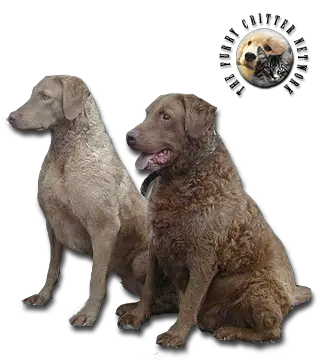Breed Standard
Head: Broad and round. Wide, domed skull. Moderate stop. Short, pointed muzzle. Lips thin, not pendulous.
Ears: Small, hanging loosely.
Eyes: Medium-sized, very pale yellowish.
Body: Medium in length (not cobby). Neck medium in length. Deep, broad chest. Tuck-up.
Tail: Medium in length, 27 to 37 cm long (10.514.5 in). Fairly thick at the base. Feathering allowed.
Hair: Thick, short, under 3.7 cm long (1.5 in). Very short on the foreface and legs. Topcoat and oily undercoat are virtually waterproof.
Coat: From dark brown to pale tan, or deadgrass ranging from tan to straw. Small white spots on the chest and toes are allowed.
Size: Dog: 58 to 66 cm. (22.8-26 in).Bitch: 53 to 61 cm. (21-24 in).
Weight: Dog: 29 to 34 kg. (64-75 lb).Bitch: 25 to 29 kg. (55-64 lb).
History
This breed was developed in the northeastern United States, in the Chesapeake Bay region of Maryland, where he is used for his exceptional hunting skill in swampland. He is thought to have been developed by crossing the canine survivors of a shipwreck off the coast of Maryland in 1807 with the Curly-coated Retriever, the Flat-coated Retriever, the Otterhound, the Irish Setter, and Irish water dogs. He was first shown in Baltimore in 1876. The first standard was written in 1890, and a breed club was founded in 1918. He is rare in Europe, despite being a fairly old breed.
Behavior
The quintessential Chesapeake Bay Retriever has a bright and happy disposition, intelligence, quiet good sense, and an affectionate protective nature. Some can be quite vocal when happy, and some will 'smile' by baring their front teeth in a peculiar grin; this is not a threat, but a sign of joy or submissiveness.
Chesapeake Bay Retrievers can make excellent family dogs when socialized properly. Some Chesapeakes are assertive and willful and may be reserved with strangers, but others are passive and outgoing with people.
The Chesapeake Bay Retriever is a versatile breed competing in field trials, hunt tests, conformation, obedience, agility and tracking, yet remains true to its roots as a hunting dog of great stamina and ability. The Chesapeake Bay Retriever is an intelligent breed and learns at a high speed. Historically considered stubborn and difficult to train, many trainers thought this breed required more physical discipline than other retriever breeds. Some trainers now recommend that the Chesapeake Bay Retriever owner use consistent, daily obedience training with play time before and after to keep the dog wanting to work with little or no physical discipline required.
He needs space and lots of exercise, as well as regular brushing.
Function
Hunting Dog, Pet.
Health
The breed is subject to a number of hereditary diseases. These include, but are not limited to:
Exercise-induced collapse
Hip dysplasia
Progressive retinal atrophy
Type 3 von Willebrand disease
Regional Alopecia in both sexes
Cataracts
A UK Kennel Club survey puts the median lifespan of the breed at 10.75 years (average 9.85). A US breed club survey puts the average lifespan at 9.4 years. 1 in 4 lived to 13 years or more while 1 in 5 don't live past 5 years.






